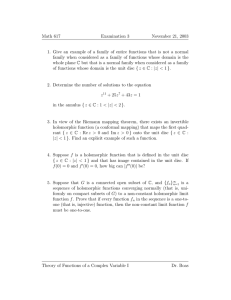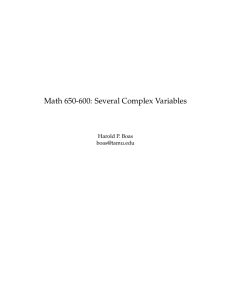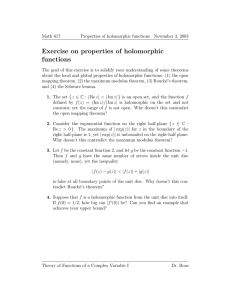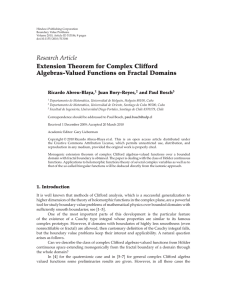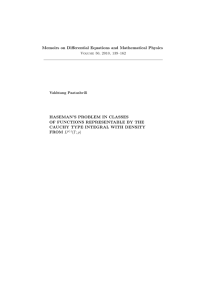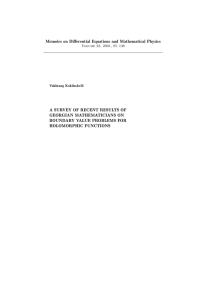Announcement
advertisement
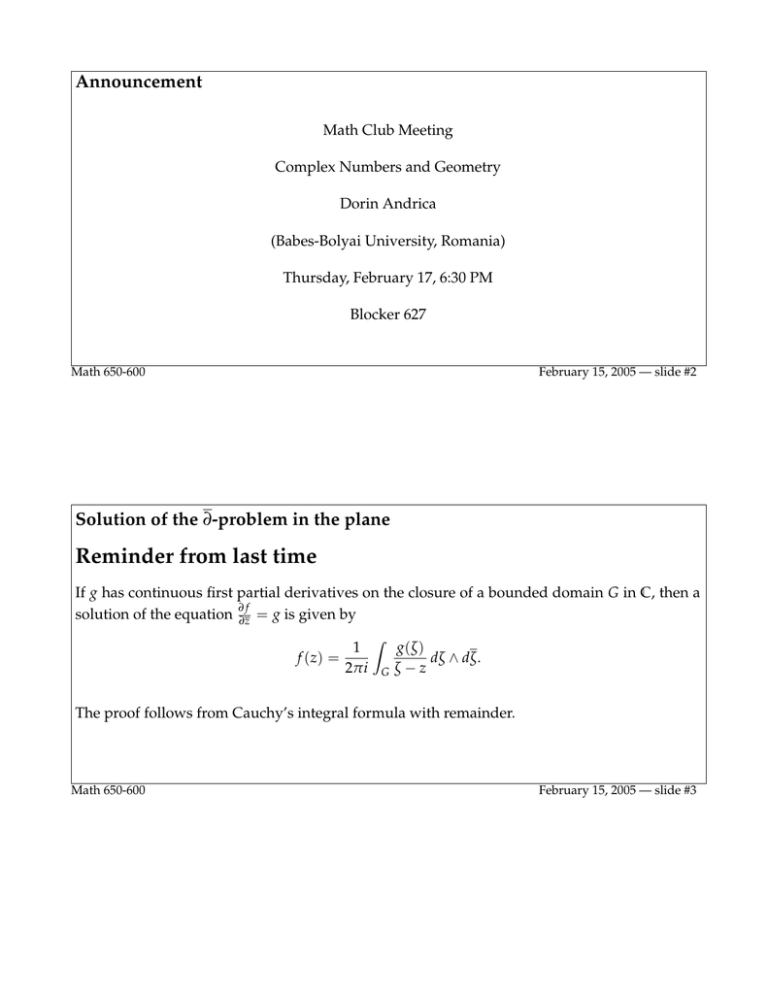
Announcement
Math Club Meeting
Complex Numbers and Geometry
Dorin Andrica
(Babes-Bolyai University, Romania)
Thursday, February 17, 6:30 PM
Blocker 627
Math 650-600
February 15, 2005 — slide #2
Solution of the ∂-problem in the plane
Reminder from last time
If g has continuous first partial derivatives on the closure of a bounded domain G in C, then a
∂f
solution of the equation ∂z = g is given by
1
f (z) =
2πi
Z
G
g(ζ)
dζ ∧ dζ.
ζ−z
The proof follows from Cauchy’s integral formula with remainder.
Math 650-600
February 15, 2005 — slide #3
Exercises on ∂ in the plane
1. Find an explicit (smooth) solution to the equation ∂ f /∂z = 1/z in the punctured plane
C \ {0}.
2. Find an explicit (smooth) solution to the equation ∂ f /∂z = 1/z in the punctured plane
C \ {0}.
Math 650-600
February 15, 2005 — slide #4
Natural boundary in the plane
n
1 2
Example. The power series ∑∞
n=1 n! z represents a holomorphic function in the open unit disc
{ z ∈ C : |z| < 1 } that extends to be a class C ∞ function on the closed unit disc { z ∈ C : |z| ≤ 1 }
but that does not admit an analytic continuation to a neighborhood of any boundary point.
The fact that the unit circle is the natural boundary for this series follows (for instance) from the
Hadamard gap theorem:
pn
If {pn } is an exponentially increasing sequence of positive integers, then the series ∑∞
n=1 an z
does not extend holomorphically across any boundary point of its disc of convergence.
Here “exponentially increasing” means that there exists a positive number λ such that p n+1 ≥
(1 + λ)pn for all n.
Math 650-600
February 15, 2005 — slide #5
Domains of holomorphy
Theorem/definition. A connected open set Ω in C n is called a domain of holomorphy if either
of the following two equivalent properties holds.
1. There exists a holomorphic function on Ω that does not extend holomorphically across
any part of the boundary.
2. For every point p in the boundary of Ω, there exists a holomorphic function on Ω that
does not extend holomorphically across the boundary at p.
Obviously (1) =⇒ (2). We will prove the converse later.
The precise meaning of “ f does not extend holomorphically across the boundary at p” is “there
do not exist a connected neighborhood U of p and a non-empty open subset V of U ∩ Ω and a
holomorphic function F on U such that F| V = f .”
Math 650-600
February 15, 2005 — slide #6
Solving ∂ when n ≥ 2
Theorem. When n ≥ 2, if g = ∑nj=1 g j (z) dz j satisfies the compatibility condition ∂g = 0, and if
each g j is a continuously differentiable function having compact support in C n , then there is a
compactly supported continuously differentiable function f such that ∂ f = g.
Z
1
g1 (ζ, z2 , . . . , zn )
Proof. Set f (z1 , . . . , zn ) =
dζ ∧ dζ.
2πi C
ζ − z1
Then ∂ f /∂z1 = g1 by the one-variable case previously considered. When j > 1, pass the derivative ∂/∂z j under the integral sign and use the compatibility condition to replace ∂g 1 /∂z j with
∂g j /∂ζ. The one-variable Cauchy formula with remainder implies that ∂ f /∂z j = g j .
Finally, f has compact support because f is holomorphic outside a compact set, and f vanishes
when |zn | is large.
Math 650-600
February 15, 2005 — slide #7
Exercise: 1 6= 2
In contrast to the situation when n ≥ 2, show that in C, if g has compact support but
dz 6= 0, then no function f such that ∂ f /∂z = g can have compact support.
Math 650-600
R
C
g(z) dz ∧
February 15, 2005 — slide #8



